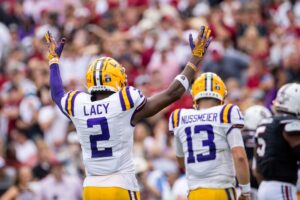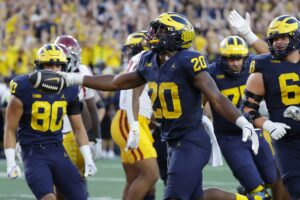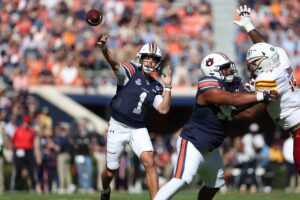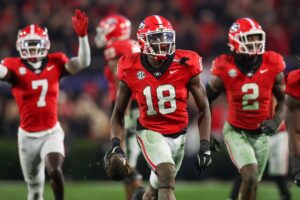Looking closely at this year’s football team reveals remarkable similarities between the 2009 and 2021 Hawkeyes. Ricky Stanzi led the 2009 Iowa Hawkeyes to a BCS bowl for the first time since the 2002 season. In one of Kirk Ferentz’s best teams in his tenure, Iowa finished the regular season 10-2 and second in the Big Ten. Iowa then went on to win the Orange Bowl against Georgia Tech’s triple-option in dominant fashion. That season probably ranks in the top three best seasons under Ferentz. This year, Iowa has similar pieces in place to make another run. Nearly every position group stacks up almost strikingly similar to that of 12 years ago. The Hawkeyes have a lot of upside potential heading into this season.
Similarities Between The 2009 And 2021 Hawkeyes
Quarterback
2009: Ricky Stanzi
2021: Spencer Petras
Stanzi entered the 2009 season as a second-year starter after earning the job early in 2008. He split time with Jake Christensen for the first four games of the 2008 season. Stanzi struggled early against Iowa State, throwing for only 95 yards and two interceptions. Iowa got the win against the Cyclones, but he followed that performance with three losses to Pitt, Northwestern, and Michigan State. At 3-3, the season started to look lost. However, Stanzi had earned the starting role and ultimately turned the season around. Iowa ended the year by winning six of the final seven. That included a massive home victory over third-ranked Penn State. After a position battle and a rough beginning of the 2008 season, the Hawkeyes won the Outback Bowl and finished 9-4.
Spencer Petras had to fight similar adversity entering his first year under center. With COVID-19, Spring practice was canceled, and he had extremely limited fall practice in the delayed season. Petras started the year 0-2 against Purdue and Northwestern. He struggled to finish out those games and looked inconsistent at times. Like Stanzi, Petras flipped a switch and led Iowa on a six-game win streak to end the year. That streak included a dominant win over Wisconsin to reclaim the Heartland Trophy for the first time since 2015. Petras showed his capabilities in a short year and, like Stanzi, proved himself as the starter for the following season.
In 2009, Stanzi’s second year as the starter, he led the Hawkeyes to a 9-0 beginning of the season. Iowa climbed the rankings and had legitimate National Title hopes. But the team fell to Northwestern and Ohio State before ending the year 10-2. Now, Petras gets his turn as the second-year leader of the Iowa offense. He’ll have some similar weapons at his disposal and a chance to make a run like Stanzi did 12 years earlier.
Wide Receiver
2009: Derrell Johnson-Koulianos, Marvin McNutt, Trey Stross, Keenan Davis
2021: Tyrone Tracy Jr., Nico Ragaini, Charlie Jones, Keagan Johnson
The 2009 wide receiver room had depth. Junior Derrell Johnson-Koulianos was Stanzi’s top target. He led the team with 750 receiving yards that season. Marvin McNutt was a sophomore in 2009 with a high ceiling. McNutt was a quarterback recruit but switched to receiver early on due to his athleticism. He led the team with eight receiving touchdowns that year. Trey Stross was the senior in the group and he brought another element of toughness to the receiver room. Finally, Keenan Davis was a true freshman with a big upside. He was a four-star receiver out of high school and added to the overall depth at the position. All four of these guys were used throughout the 2009 season, but Johnson-Koulianos and McNutt got the bulk of the touches. With two dynamic playmakers on the outside, Stanzi had several options in the passing game.
The Hawkeyes won’t have quite as much depth at the position this season, but the talent is there. Like Johnson-Koulianos, Tyrone Tracy Jr. will be the top target in his junior season. He’ll likely get touches in the wildcat in addition to opportunities through the air. On the other side of the field is Nico Ragaini. He has been in the program since 2018 and his toughness and agility make him a dependable target. The third guy at receiver is senior Charlie Jones. He gets the punt return work and brings another option to the passing game. The true freshman is Keagan Johnson. Similar to Davis, Johnson was a highly-rated recruit and brings a lot of upside to the Iowa offense. While he might not get a big number of touches this season, he’ll bring additional depth and skill to the air as Davis did in 2009.
Tight End
2009: Tony Moeaki, Allen Reisner
2021: Sam LaPorta, Luke Lachey
Tony Moeaki was one of the highest-graded tight ends that Iowa has ever brought to the program. He battled injuries for a lot of his career but was granted a fifth year to come back in 2009. Moeaki was a pivotal part of the offense and ended the season with four touchdowns in 10 games. Backup Allen Reisner saw a good amount of playing time that season as well. He played in all 13 games in 2009 and had one touchdown.
This season, Sam LaPorta enters his third year as a starting tight end. Like Moeaki, he was a highly-touted recruit and plays a big role in the position. His experience will be similar to Moeaki’s, but luckily he hasn’t had to battle injury. A backup is redshirt freshman Luke Lachey. Although young, Lachey is a big guy, bigger than Reisner, and has a lot of upside potential.
Offensive Line
2009: Bryan Bulaga
2021: Tyler Linderbaum
The 2009 offensive line had a lot of experience and future NFL talent. The one player that stood out was Bryan Bulaga. The converted defensive lineman was entering his junior season in 2009 and had several experts predicting him as a top 15 draft pick. He eventually went 23rd overall to the Packers the following April. He had high preseason expectations and led the Hawkeye offensive line at tackle.
This year, Iowa has another player with a lot of expectations and several preseason awards. Tyler Linderbaum will play center in his junior season with Iowa. He brings a veteran presence to, arguably, the most important position on the field. Linderbaum plays a different position than Bulaga, but the high regards are very similar. Like Bulaga, Linderbaum will be the leader in the trenches.
Defensive Backs
2009: Brett Greenwood, Amari Spievey, Tyler Sash, Shaun Prater, Micah Hyde
2021: Matt Hankins, Jack Koerner, Kaevon Merriweather, Riley Moss, Dane Belton
The 2009 Hawkeye defensive backs were elite. While younger than what Iowa has this season, they brought a lot of experience to the field. Brett Greenwood and Amari Spievey were the two juniors and received All-Big Ten Honors the previous year. Tyler Sash and Shaun Prater were young sophomores. Sash had 85 tackles on the year and led the team with six interceptions including the pinball pick-six against Indiana on Halloween. Micah Hyde was only a freshman but played in all 13 games that season.
The similarities between the 2009 and 2021 Hawkeyes in the secondary are undeniable, while this year’s defensive backs have even more experience. Matt Hankins, Jack Koerner, and Riley Moss are all seniors and have been starters for multiple seasons. Koerner is similar to Sash in size and that he is a no-fly zone safety. Kaevon Merriweather and Dane Belton are both juniors and bring dynamic abilities to the secondary. Their speed is similar to that of Prater and Spievey, and they are both great pass defenders. Cooper DeJean is the freshman safety for Iowa this year. Who knows, he could emerge as the next Hyde.
Defensive Line
2009: Adrian Clayborn, Christian Ballard, Broderick Binns, Karl Klug, Mike Daniels
2021: Zack VanValkenburg, John Waggoner, Yahya Black
The 2009 defensive line lost a lot prior to the season. Mitch King was an All-American in 2008, and Matt Kroul earned All-Big Ten honors that year. Both moved on to the NFL following the season. The 2021 Hawkeye defense is in a similar spot after losing Consensus All-American Daviyon Nixon and First Team All-Big Ten Chauncey Golston. The line has some holes to fill, but Iowa did it back in ‘09, and all signs point to having the same pieces to do it again this season.
Adrian Clayborn was the anchor of the 2009 Iowa defensive front. He had an 11.5 sack season in 2009 and was the veteran on the line. Clayborn was joined by Christian Ballard who rotated with Broderick Binns at the other end spot. Ballard was an experienced second-year starter as a junior. Binns was a sophomore and put up great numbers in the rotation. Both received All-Big Ten honors following the season. Karl Klug stepped in as a fourth-year junior and started on the interior line. He earned defensive player of the week honors despite not being the starter all season. The new face of the group was Mike Daniels. He didn’t have a lot of experience prior to the 2009 season, but played all 13 games and ended up being one of the best defensive linemen in the Ferentz era.
Zack VanValkenburg is the veteran guy on the line for 2021. He is joined by fourth-year junior John Waggoner. Like Klug, he has seen action heading into the season but will be in the starting role for the first time. Yahya Black is the new guy on the line this year. Like Daniels, he has had very limited experience in only four games of action. Black was a very highly rated recruit and has a high ceiling for the Hawkeyes. If he shows up early, he could be a major difference-maker for the defense like Daniels was in 2009.
Punter
2009: Ryan Donahue
2021: Tory Taylor
Ryan Donahue was one of Iowa’s best punters in recent history. After redshirting his first season, he started all 51 games of his career at Iowa. Donahue averaged over 40 yards per punt in each season and has five of the 14 longest punts in Iowa history. That includes an 82-yard bomb. During the 2009 season, Donahue punted 61 times for 2,500 yards. That yardage ranked fourth in the conference. The punt team played an important role in field position all season and was a big reason why Iowa came out on top 10 times.
This season, Tory Taylor will be a sophomore punter for Iowa. He averaged 44 yards per punt last season. While only a sophomore at Iowa, he is 24 years old and has experience punting in Australian rules football. His ability to punt for both distance and accuracy is a great advantage for the Hawkeyes in field position. Like in 2009, a solid punt team can make the difference in close games, and Iowa has it this year. Even in the punt game, the similarities between the 2009 and 2021 Hawkeyes are strong.
The Pieces are in Place
The similarities between the 2009 and 2021 Hawkeyes football teams are undeniable. The only real difference between the two teams is at running back. After 2008, Iowa lost Doak Walker Award winner Shonn Green to the NFL. Ferentz had to work with some new faces at running back including Brandon Wegher and Adam Robinson. This year’s Hawkeyes have Tyler Goodson in the backfield. Goodson has proven his skills over the last two seasons and is getting national attention as one of the best backs in the conference. The veteran brings a huge advantage to the 2021 Hawkeye offense.
In 2009, Iowa had all the pieces for a conference championship run. They lost some playmakers entering the year, but the new guys stepped up. Daniels was ready to go as a young defensive lineman. Johnson-Koulianos and the receiver room stepped up to give Stanzi a lot of options, and the veteran defensive backs shut down opponents all season long. This fall, Iowa will miss guys like Nixon and Ihmir Smith-Marsette, but it’s all about the next man in. Black has a prime opportunity to elevate this young defensive line. Tracy Jr. is the veteran at wideout, and the defensive backs are more than experienced. Just like in 2009, the pieces are back in place and this Hawkeye team is ready to make another run. In the words of Stanzi, “If you don’t love it, leave it.”






